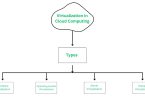With the increasing use of cloud services in organizations as a way to store data and achieve computing capabilities, the need for securing cloud implementation has become a top priority for companies of different scales. The lack of proper security measures may result in vulnerable cyber threats and attacks on the data stored in the cloud. While detailed planning and stringent security procedures can be a challenge, cloud computing can deliver security levels that match or exceed those of traditional on-site systems.
Organizations can therefore take advantage of cloud computing services and protect their data by following these steps.
Identifying Cloud Security Needs:
It is important to assess the sensitivity, value and any regulatory or compliance obligations associated with your data before employing cloud security measures. Knowing these factors is a crucial point in matching the security measures to the organizational goals.
On the other hand, evaluating your present security status helps to pinpoint existing security vulnerabilities or deficiencies that have a good chance of being fixed if you use the right cloud security solutions.
Cloud Security Policies and Procedures:
Cloud security policies have been thoroughly developed rules for data access, usage, and protection. These policies should be customized to address individual security requirements and be clearly articulated to all the parties concerned. Building up the procedural frameworks for implementing these policies calls for training of the security personnel on security protocols, conducting routine security audits and imposing strict access control measures.
Picking a Trustworthy Cloud Service Provider:
The selection of the right cloud service provider is a critical component of data protection. Provider evaluation is the process of examining their reputation, record and the security certifications they possess. Evaluating their data security abilities, for example, encryption protocols, data backup methods and incident response strategies, guarantees that they meet your organization’s security requirements.
The Access Control Measures Should Be Enforced:
IAM solutions play a key role in managing the identities of the users and also in regulating access to cloud resources. This entails the use of multi-factor authentication, identification of user roles and privileges, and user activities monitoring. The other value is that firewalls and network security groups provide an extra layer of security and prevent unauthorized access and malicious attempts in the cloud environment.
Encrypting Cloud Data:
Encryption is the principal shield for the confidential information that is stored on the cloud. Creating different encryption methods and algorithms that provide unreadable data without the decryption key is the way to go.
Symmetric-key encryption utilizes one key for both encryption and decryption operations.
The asymmetric encryption makes use of two different keys, one public and the other private, for encrypting and decrypting the data, respectively.
Hashing transforms data to a fixed-length string that is non-reversible to the original form, thereby ensuring the integrity and confidentiality of the data.
Cloud Environment Auditing and Monitoring:
Regular monitoring and auditing are precarious acute processes for keeping clouds secure and acquiescent with regulations. Such measures involve the formation of monitoring systems and running regular security audits and evaluations. Monitoring systems should be designed to be constantly working and detecting any unusual events or security breaches in the cloud environment. In addition, notifications must be configured in a way that makes them react promptly and inform relevant personnel or security teams about detected anomalies or security breaches.
Disaster Recovery Plans of Cloud Technology:
The development of disaster recovery plans is a key element to prevent the catastrophic consequences of such events on organizational operations.
A disaster recovery plan that covers all bases should be devised to ensure that critical business functions continue to run uninterruptedly and that all the important data is preserved.
The first step of this process is to identify the essential business functions and to list the data that the business must have to run its operations.
It is also a matter of drawing the line between the most important applications, data and systems that are vital for business continuity. The disaster recovery plan must be designed to have backup and recovery procedures, disaster recovery test protocols, and communication methods that are tailored to engage stakeholders effectively.
Best Practice Implementation in Cloud Security:
Adopting the best practices of cloud security significantly reduces the risk of breaches and it will also maintain the security and regulatory compliance of cloud environments. These methods entail the creation of superior access controls, timely vulnerability patching, and employee training on security awareness. Through the adoption of these best practices and staying up-to-date on the latest security threats, organizations will be in a position to protect the integrity of their cloud environments and secure their sensitive data from possible security breaches.
Conclusion:
The cloud security is a priority as the cloud becomes the most popular option for businesses. This post has laid out the most crucial step roadmap for strong cloud security, ranging from needs assessment to disaster recovery plans. Through the use of best practices, taking advantage of novel technologies and creating a culture of security awareness, organizations can explore the power of cloud computing with confidence. The future is promising, with cloud security evolving to give better security through AI and automation. Are you prepared for a safe cloud voyage? Feel free to share your ideas and experiences with us in the comments below.






Leave a Comment